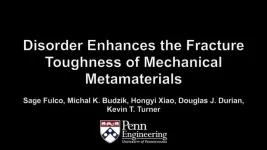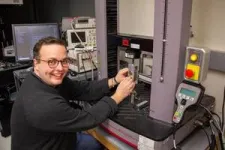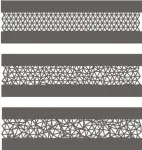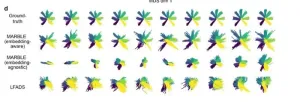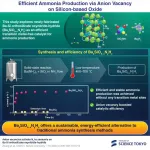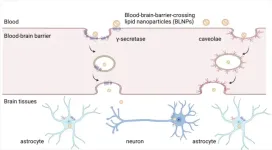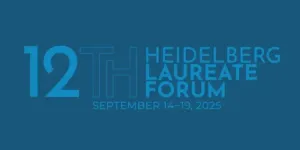(Press-News.org) Cut open a bone and you’ll see a subtly disordered structure. Tiny beams, called trabeculae, connect to one another in irregular patterns, distributing stress and lending bones an impressive toughness. What if human-made materials could exhibit similar properties?
In a new paper in Proceedings of the National Academy of Sciences Nexus, researchers at Penn Engineering, Penn Arts & Sciences and Aarhus University found that adding just the right amount of disorder to the structure of certain materials can make them more than twice as resistant to cracking.
The finding opens the door to more widespread use of so-called “mechanical metamaterials,” a class of materials whose internal structures — often produced via digital manufacturing techniques such as 3D printing and laser cutting — give them unique properties, including enhanced strength or stiffness per weight.
Until this point, one of the greatest challenges posed by mechanical metamaterials has been their fragility. “Toughness is a limiting factor in not all, but many 3D-printed mechanical metamaterials,” says Kevin Turner, Professor and John Henry Towne Department Chair of Mechanical Engineering and Applied Mechanics (MEAM) at Penn Engineering and the paper’s senior author.
This new result promises to address this issue and at relatively low cost. “Without changing the material at all, just simply by altering the internal geometry,” says Turner, “you can increase the toughness by 2.6 times.”
Inspired by Nature
Natural materials commonly exhibit disorder at small scales. In addition to human bone, the researchers point to nacre, the iridescent material inside seashells, and the threads mussels use for attaching to surfaces. Rather than regular repeating structures, these materials contain minute, seemingly random variations in the space between their structural components.
For decades, engineers have taken inspiration from nature, but often by replicating easy-to-manufacture structures like a honeycomb pattern, which reduces a material’s weight while maintaining its strength. Honeycomb structures can be found in some cardboard packaging and the metal reinforcements inside airplane wings. “That’s a very regular pattern,” Turner points out.
In contrast, the metamaterials tested in the paper exhibited a wide range of patterns, from regular to highly disordered. “The samples that performed the best, in which it was most difficult for a crack to grow, did not consist of regular repeating patterns,” says Sage Fulco, a postdoctoral researcher in MEAM and the paper’s lead author. “They had different geometry in different areas.”
Testing the Limits of Disorder
To test whether disorder makes mechanical metamaterials tougher, the researchers performed thousands of computational mechanics simulations of numerous different patterns, all based on a triangular lattice, called a truss. In some, the triangles were arranged in perfect symmetry, while in others, the pattern had been perturbed by moving the nodes where the triangles meet.
The team subjected the patterns to rounds of computer simulations and created physical versions of a representative set of geometries, including both ordered geometries and those with varying levels of disorder.
When they attempted to break the materials — in the lab and in the simulations — a clear trend emerged. “There was a specific level of disorder, so that the patterns we cut into the material looked somewhat regular but not exactly symmetrical, where we were able to achieve the highest level of performance,” says Fulco.
Striking the Right Balance
The perfect level of disorder — not too little, or too much — retained most of the material’s strength and stiffness while enhancing its toughness, but took substantially more effort to design than a repeating structure. “Disordered systems aren’t often used in engineering because the design is much more complex,” Turner points out.
Fulco worked with Michael Budzik, Associate Professor in Mechanical and Production Engineering at Aarhus University, to fine-tune the fabrication process, traveling to Denmark to use an extremely precise laser cutter in Budzik’s lab to carve the patterns. “I had to completely rebuild our experimental setup to make use of their fabrication equipment,” says Fulco. “But that allowed the experiments to actually succeed.”
Visualizing the Strength of Disorder
To understand how the disordered structures increased toughness, the team ran an experiment conceived in collaboration with Douglas Durian, Mary Amanda Wood Professor in Physics and Astronomy at Penn Arts & Sciences, and Hongyi Xiao, then a postdoctoral fellow in Durian’s lab. (The four were researchers in Penn’s Materials Research Science and Engineering Center, or MRSEC).
When certain materials — including the polymer into which Fulco cut the patterns — are stretched, their birefringence, a property that causes light to split into two different paths, changes. Viewed through the right setup, the material’s appearance shifts with different levels of mechanical stress.
By taking images of samples with different patterns — some with a regular pattern and others with varying levels of disorder — while loading them to failure, the researchers were able to visualize exactly what happened as cracks propagated through the materials.
In short, the disorder prevented cracks from traveling in straight lines. “For the crack to grow through a disordered material, damage has to occur over a much larger area,” says Fulco. In images captured by the team, fracture events appear closer together in a straight line in the symmetrical sample, but are scattered about in the optimally disordered one.
Going Beyond the Lab
Moving forward, the researchers hope their findings will encourage a broader exploration of disordered patterns in mechanical metamaterials and mechanical design. “We used triangles, but this work is very fundamental,” says Fulco. “Other groups can apply it to many different geometries.”
The success of the nature-inspired design also suggests that engineers may have significantly more to learn from the design of natural materials. “Combining different types of materials and adding different geometries at different scales are very exciting opportunities,” says Fulco. “That’s what we see when we look at the highest performing natural materials.”
Ultimately, the team envisions these advances leading to the development of improved materials and structures with applications in industries like aerospace, where resisting crack growth and tolerating damage are critical. “We're enabling broader use of mechanical metamaterials in structural applications by identifying a geometric route to increase toughness,” says Turner.
This study was conducted at Penn Engineering, the University of Pennsylvania School of Arts & Sciences and Aarhus University and supported by the National Science Foundation (NSF) MRSEC program (awards DMR-1720530 and DMR-2309043), the National Defense Science & Engineering Graduate (NDSEG) Fellowship Program, and the Villum Foundations under the Villum Experiment programme (VIL50302).
END
Breaking the pattern: How disorder toughens materials
Engineers tweak metamaterial geometry to increase toughness
2025-02-17
ELSE PRESS RELEASES FROM THIS DATE:
A geometric deep learning method for decoding brain dynamics
2025-02-17
In the parable of the blind men and the elephant, several blind men each describe a different part of an elephant they are touching – a sharp tusk, a flexible trunk, or a broad leg – and disagree about the animal’s true nature. The story illustrates the problem of understanding an unseen, or latent object based on incomplete individual perceptions. Likewise, when researchers study brain dynamics based on recordings of a limited number of neurons, they must infer the latent patterns of brain dynamics that generate these recordings.
“Suppose you and I both engage in a mental task, ...
Novel catalyst development for sustainable ammonia synthesis
2025-02-17
As the world moves toward sustainability, the demand for efficient alternatives across industries continues to grow. Ammonia, a key chemical used in fertilizers, explosives, and various other products, is primarily synthesized through the energy-intensive Haber-Bosch process. This process requires extremely high temperatures and pressures, contributing to global carbon dioxide emissions. Conventional catalysts, such as iron and ruthenium, rely on these harsh conditions to drive the reaction. However, a recent study by researchers from Institute of Science Tokyo, the National Institute for Materials Science, and Tohoku University, Japan, led by Professor Masaaki Kitano, explores ...
Researchers identify DNA changes, biological pathways associated with inherited cancer risk
2025-02-17
Thousands of single changes in the nucleotides that make up the human genome have been associated with an increased risk of developing cancer. But until now, it’s not been clear which are directly responsible for the uncontrolled cellular growth that is the hallmark of the disease and which are simply coincidences or minor players.
Stanford researchers have conducted the first large-scale screen of these inherited changes, called single nucleotide variants, and homed in on fewer than 400 that are essential to initiate and drive cancer growth. These variants control several common biological ...
New lipid nanoparticle platform delivers mRNA to the brain through the blood-brain barrier
2025-02-17
New York, NY [February 17, 2025]—Scientists at the Icahn School of Medicine at Mount Sinai have developed a lipid nanoparticle system capable of delivering messenger RNA (mRNA) to the brain via intravenous injection, a challenge that has long been limited by the protective nature of the blood-brain barrier.
The findings, in mouse models and isolated human brain tissue, were published in the February 17 online issue of Nature Materials [10.1038/s41563-024-02114-5]. They demonstrate the potential of this technology to pave the way for ...
Wildfires in the Andes cause severe soil degradation and hinder ecosystem recovery
2025-02-17
In September 2018, a wildfire burned nearly two thousand hectares of shrubland on the Pichu Pichu volcano, an ecologically significant area in the Peruvian Andes. Unlike Mediterranean ecosystems, where vegetation has evolved strategies to withstand fire, the volcanic soils of Arequipa—one of the driest regions in the world—are not adapted to wildfire disturbances. A Miguel Hernández University of Elche (UMH) research team collected and analyzed soil samples from the burned area at 3,700 meters above sea level to understand how these fragile ecosystems ...
Men and boys matter: Psychology professor reveals hidden issues we need to talk about
2025-02-17
These include those linked to body image, fatherhood and sexual relationships. His latest book - Current Issues Facing Men and Boys – also argues that men struggle to negotiate harmful notions of masculinity and are not included in conversations around gender.
Current Issues Facing Men and Boys urges the public, policymakers, practitioners and other key stakeholders to explore and support policies and practices that promote male wellbeing. This book comes as the UK government announces plans for the country's first men's health strategy, aiming ...
1 in 6 parents support teens getting non-surgical cosmetic procedures with parental consent
2025-02-17
For teens who may be self-conscious about issues such as acne scarring or discolored teeth, non-surgical cosmetic procedures are an increasingly popular way to address their concerns.
And some parents are supportive of this decision, a national poll suggests, with a sixth saying teenagers should be allowed to receive these types of aesthetic treatments for any reason as long as they have parental approval.
But half of parents only support teens getting non-surgical cosmetic procedures if there’s a valid reason – and their beliefs about which reasons count as valid differ – according to ...
Journalist travel grants available for 12th Heidelberg Laureate Forum
2025-02-17
This September, recipients of the Abel Prize, ACM A.M. Turing Award, ACM Prize in Computing, Fields Medal, IMU Abacus Medal and the Nevanlinna Prize are invited to gather in Heidelberg to meet with 200 young researchers from all over the world at the 12th Heidelberg Laureate Forum (HLF). In order to reach a broader, more diverse and international audience, the Heidelberg Laureate Forum Foundation (HLFF) encourages journalists to cover the event and affords them the chance to interact with the preeminent scientists of mathematics and computer science. The 12th HLF will take ...
Are we still primitive? How ancient survival instincts shape modern power struggles
2025-02-17
The evolutionary roots of human dominance and aggression remain central to social and political behaviour, and without conscious intervention these primal survival drives will continue to fuel inequality and division.
These are the arguments of a medical professor who, as global conflicts rise and democracies face growing challenges, says understanding how dominance and tribal instincts fuel division is more critical than ever.
In A New Approach to Human Social Evolution, Professor Jorge A. Colombo MD, PhD explores neuroscience, anthropology, and behavioural science to provide a new perspective on human social evolution.
He argues that fundamental behavioural drives ...
Near-complete skull discovery reveals ‘top apex’, leopard-sized “fearsome” carnivore
2025-02-17
A rare discovery of a nearly complete skull in the Egyptian desert has led scientists to the “dream” revelation of a new 30-million-year-old species of the ancient apex predatory carnivore, Hyaenodonta.
Bearing sharp teeth and powerful jaw muscles, suggesting a strong bite, the newly-identified ‘Bastetodon’ was a leopard-sized “fearsome” mammal. It would have been at the top of all carnivores and the food chain when our own monkey-like ancestors were evolving.
Findings, published in the peer-reviewed Journal of Vertebrate Paleontology, detail ...
LAST 30 PRESS RELEASES:
Post-stroke injection protects the brain in preclinical study
Cardiovascular risk score predicts multiple eye diseases
Health: estimated one in ten British adults used or interested in GLP-1 medications for weight loss
Exercise to treat depression yields similar results to therapy
Whooping cough vaccination for pregnant women strengthens babies’ immune system
Dramatic decline in new cases of orphanhood in Uganda driven by HIV treatment and prevention programs
Stopping weight loss drugs linked to weight regain and reversal of heart health markers
Higher intake of food preservatives linked to increased cancer risk
Mass General Brigham–developed cholera vaccine completes phase 1 trial
First experimental validation of a “150-year-old chemical common sense” direct visualization of the molecular structural changes in the ultrafast anthracene [4+4] photocycloaddition reaction
Lack of support for people on weight loss drugs leaves them vulnerable to nutritional deficiencies, say experts
Dogs’ dinners can have greater climate impact than owners’
Are you ready to swap salmon for sprats and sardines?
1.6 million UK adults used weight loss drugs in past year
American College of Cardiology comments on new dietary guidelines for Americans
American Society of Gene & Cell Therapy and Orphan Therapeutics Accelerator partner to advance and commercialize promising rare disease treatments
One in 14 patients having day case surgery have new or worse chronic pain 3 months after their operation
New study highlights link between eviction rates and gun violence
Heatwaves heat up soil but not toxin levels in rice, study finds
Digital modeling reveals where construction carbon emissions really come from
Turning farm waste into water filters
New study shows how the spleen helps the immune system accept a transplant
New Mayo Clinic study advances personalized prostate cancer education with an EHR-integrated AI agent
Researchers identify novel therapeutic target to improve recovery after nerve injury
Microbes in breast milk help populate infant gut microbiomes
Reprogramming immunity to rewrite the story of Type 1 diabetes
New tool narrows the search for ideal material structures
Artificial saliva containing sugarcane protein helps protect the teeth of patients with head and neck cancer
Understanding the role of linear ubiquitination in T-tubule biogenesis
Researchers identify urban atmosphere as primary reservoir of microplastics
[Press-News.org] Breaking the pattern: How disorder toughens materialsEngineers tweak metamaterial geometry to increase toughness
